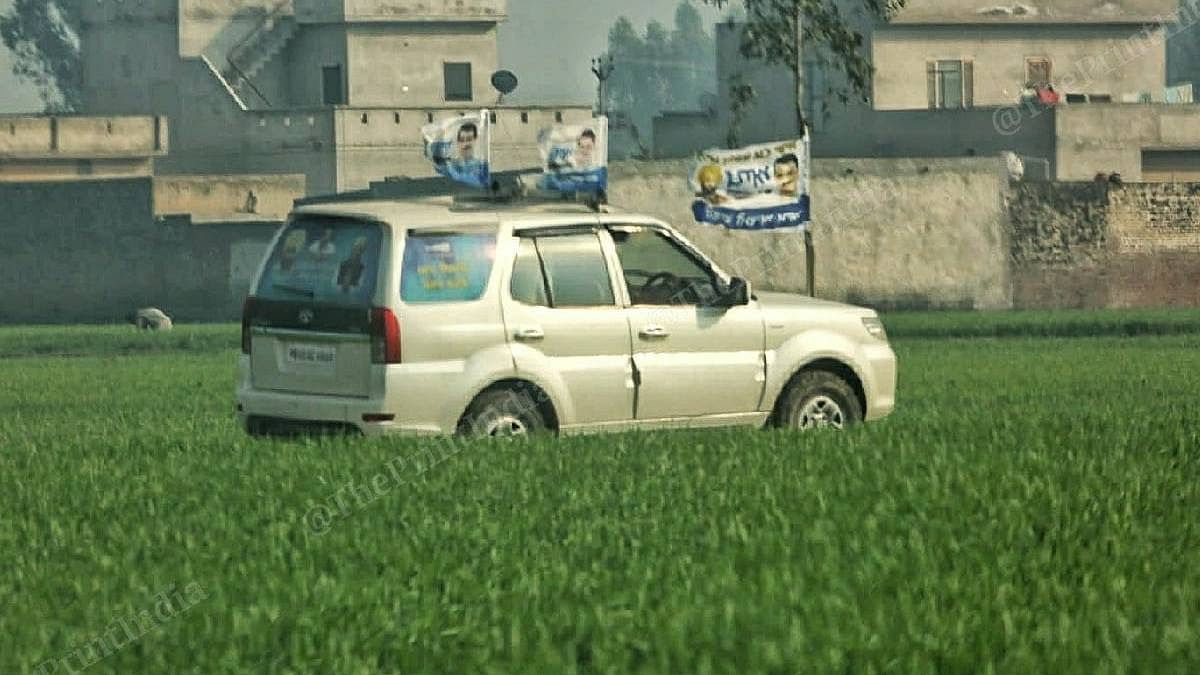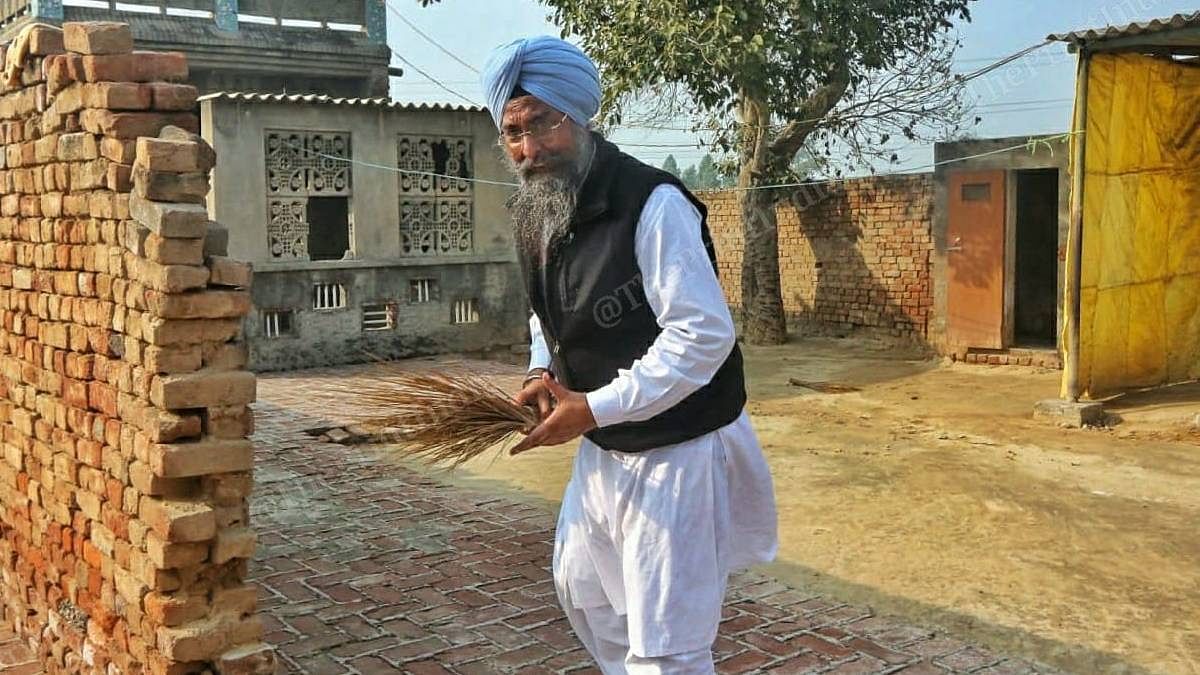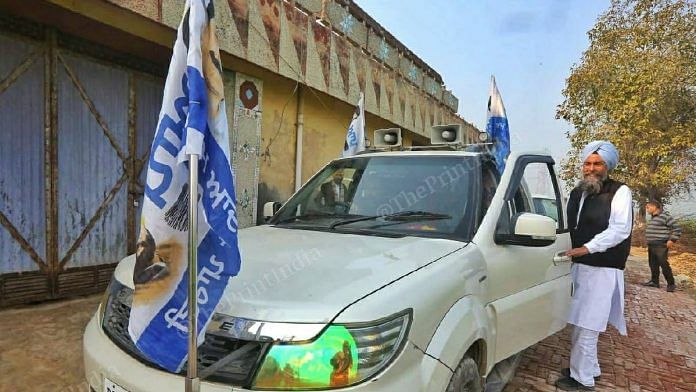Chandigarh: A Tata Safari Storme whizzing by winding, single-lane roads is a familiar sight in Kot Kapura, about 220 km west of Chandigarh. Every few minutes it screeches to a halt and a tall turbaned man with flowing grey-black beard comes out, doing a few steps of bhangra and shouting “Jo bole so nihal” and “Wahe Guruji ka Khalsa, Wahe Guruji ki fateh.” Village residents join him.
This is Kultar Singh Sandhwan, Aam Aadmi Party (AAP) MLA of Kot Kapura. His ‘connect’ with the people is there for all to see as he touches the feet of the elderly, hugs youngsters, and plays with children. In Hari Naun village in Kot Kapura Monday, he got a crowd of villagers captivated, saying no one would dream to do “beadbi” when the AAP comes to power and telling them how Delhiites just dial ‘1076’ to get government certificates and the official at the other end has to respond politely calling them “Sir”. “You don’t have to pay money to get birth or death certificates in Delhi.” Then he apologises to them for the AAP not forming the government in 2017 and promises to do it this time.
Sandhwan doesn’t have a fleet of cars with supporters following him on the campaign trail, unlike the Congress or Shiromani Akali Dal (SAD) candidates. He would rather follow Arvind Kejriwal’s advice to meet “as many people as possible”, be polite with them, and bring them to the polling booths on 20 February.

Lessons AAP learnt in 2017
It took a bit of coaxing to get him to talk about why the AAP failed to convert favourable public sentiments into votes in 2017 elections, even though it emerged as the principal opposition party with 20 seats in the 117-member assembly. Sandhwan cited four reasons.
The first was “Amarinder’s kasam” — Capt. Amarinder Singh’s pledge in 2015, with ‘Gutka Sahib’ in hand, to bring closure to sacrilege cases and change the face of Punjab — that turned out to be a ‘trump card’. The second was how “the media played up the false narrative”, as the AAP candidate says, about Kejriwal staying in an alleged Khalistani terrorist’s house. “There was nothing like it. Kejriwal didn’t even know whose house it was,” says Sandhwan.
The third was the Maur (in Bathinda) bomb blast three days before the polls. Although Sandhwan didn’t elaborate this point, it’s well-known. A time Kejriwal’s political adversaries were accusing him of joining hands with Sikh radical elements, the blast scared away moderate sections of Punjab, especially the Hindus. Planeloads of NRIs from Canada, the US, and the UK landing in Chandigarh didn’t help the AAP’s cause. The fourth reason, Sandhwan says, was the fact that the AAP had ‘tremendous support’ from the people but they were not sure if it would break the Congress-SAD stranglehold and form the government.
“It’s different now. People of Punjab are emotional. They don’t hesitate to take risks. They have decided to give Arvind Kejriwal a chance this time,” Sandhwan told ThePrint.
Travel around Punjab and meet AAP functionaries and candidates, you will hear similar views. The AAP seems to have learnt its lessons. Not that it’s not bringing volunteers from abroad any longer. Sandhwan’s driver is Ramandeep Singh Sodhi, a software developer based in Canada. He is the one who has brought Tata Safari Storme for Sandhwan and drives him around. Sodhi will go back to Canada after 20 February polling.
He has come all the way to Kot Kapura because he thinks “the AAP can bring the much-needed change in Punjab.” Sodhi drives at 100-120 km/hr on those single-lane roads and one knows he means business. Another person who occupies the rear seat in Tata Storme is Major Arvind Kumar whose family is settled in Mumbai. He has come down to Kot Kapura to help the AAP. He told ThePrint that he was ADC (aide-de-camp) to Field Marshal Manekshaw.
Sandhwan introduces Sodhi and Kumar as signs of changing times when Punjabis living outside leave their hearth and home to work for the AAP. Kejriwal’s party is no longer showing off the NRIs’ support. Blame it on the 2017 experience. The Delhi chief minister has been going to temples in Punjab since the Navratri, starting with Devi Talab Mandir in Jalandhar last October.
The so-called ‘Delhi model’ of governance and yearning for a non-Congress, non-SAD alternative have created the buzz, even though opposition leaders attribute it to the AAP’s advertisement spending.

Outside the Sapphire hotel in Bathinda last Tuesday, as crowds kept swelling waiting for SAD president Sukhbir Badal, a person in his 50’s (name withdrawn) with a badge carrying the scales (it is the Akali Dal symbol), was forthright: “Badal government did more development works between 2007 and 2017 than any other governments. But, somehow, when you go to a tea shop, you hear people talking about the AAP. Perplexing.”
A police official joined the conversation: “Yes, everyone is talking about the AAP. But there are more complex issues. I am a Jatt Sikh and I can tell you honestly. When you install a Dalit CM, the Jatt Sikhs do feel it threatens their dominance. Akali Dal has traditionally been the voice of the Jatt Sikhs. It’s possible that they (Jatt Sikhs who constitute over one-fifth of the population) rally around the SAD. But one doesn’t know.”
The SAD supporter with the badge and the police official did echo ground sentiments to a certain extent. Hari Singh, a fruit-seller from Kheta Basti in finance minister Manpreet Badal’s Bathinda (Urban) constituency, is upset about the absence of sewerage in his locality where he has been living for 40 years. 200 km east of that place, in Rajpura constituency, a group of five youngsters gathered at a dhaba aggressively argue how Punjab needed to get out of the ‘Congress-SAD trap.’
Also read: Three factors that are keeping Punjabi politicians on edge
The vote share
Dr Pramod Kumar, director of the Institute for Development and Communication, Chandigarh, has a note of caution. “Pro-changers are always noisy. The AAP is like McDonald’s. Look at its menu (manifesto or promises). You want veg burgers, the AAP is promising to deliver it. You want chicken burger… the AAP will deliver it. Whatever the voters want (freebies), the AAP can deliver. It doesn’t work.” Dr Kumar, however, concedes that the AAP can get around 20 per cent votes because of “footloose” from the Congress and the SAD.
Even 20 per cent votes may not be enough. Look at the vote shares of the Congress and the SAD over the decades. Even when the Akali Dal got 15 seats in the Punjab assembly in 2017, its vote share on the seats contested was around 30 per cent, six percentage points more than what the AAP got. The Congress’ vote share hasn’t gone below 30 per cent — not even in post- Operation Bluestar 1985 assembly election when the party got 38 per cent of the votes.
The AAP has, however, been showing a progressive decline — from a little over 24 per cent vote shares in 2014 Lok Sabha and 2017 assembly elections to around 7 per cent in 2019 Lok Sabha election. That probably explains why, for instance, pro-changers are creating a lot of buzz on the ground — although less than what they did in 2017. Nobody is inclined to wager on the AAP yet.
In a multi-cornered contest where a thousand or a couple of thousand votes may turn the scales in a constituency, the two traditional parties — the Congress and the Akali Dal — seem to be better equipped, with the AAP’s organisational structure virtually missing on the ground.
At Sukhbir Badal’s meeting in Barnala last Monday, there was a young man sitting on a bike parked bike outside while the Akali Dal show went on inside. The graduate son of labourer parents, he was making his ends meet with Rs 6,000 a month that he earned from a cloth shop. He is hoping to make Rs 2-2.5 lakh to make it to Dubai where his friend went recently and is earning Rs 45,000 a month. He was at Badal’s show because a municipal councillor had promised to get him a job in Barnala if the SAD wins. While he loved the possibility of a third alternative, the AAP, to bring about the change, he would wait outside Badal’s meeting venue, showing loyalty for the municipal councillor to deliver on his promise post-polls.
While the so-called Delhi model continues to evoke public curiosity across Punjab, how much of that will get converted into votes on 20 February will determine the AAP’s future in Punjab and at the national level. 2017 experience must haunt AAP leaders.
(Edited by Neha Mahajan)
Also read: Does anyone talk about ‘Udta Bollywood’? Sukhbir Badal says ‘Udta Punjab’ a lie, drugs no issue



